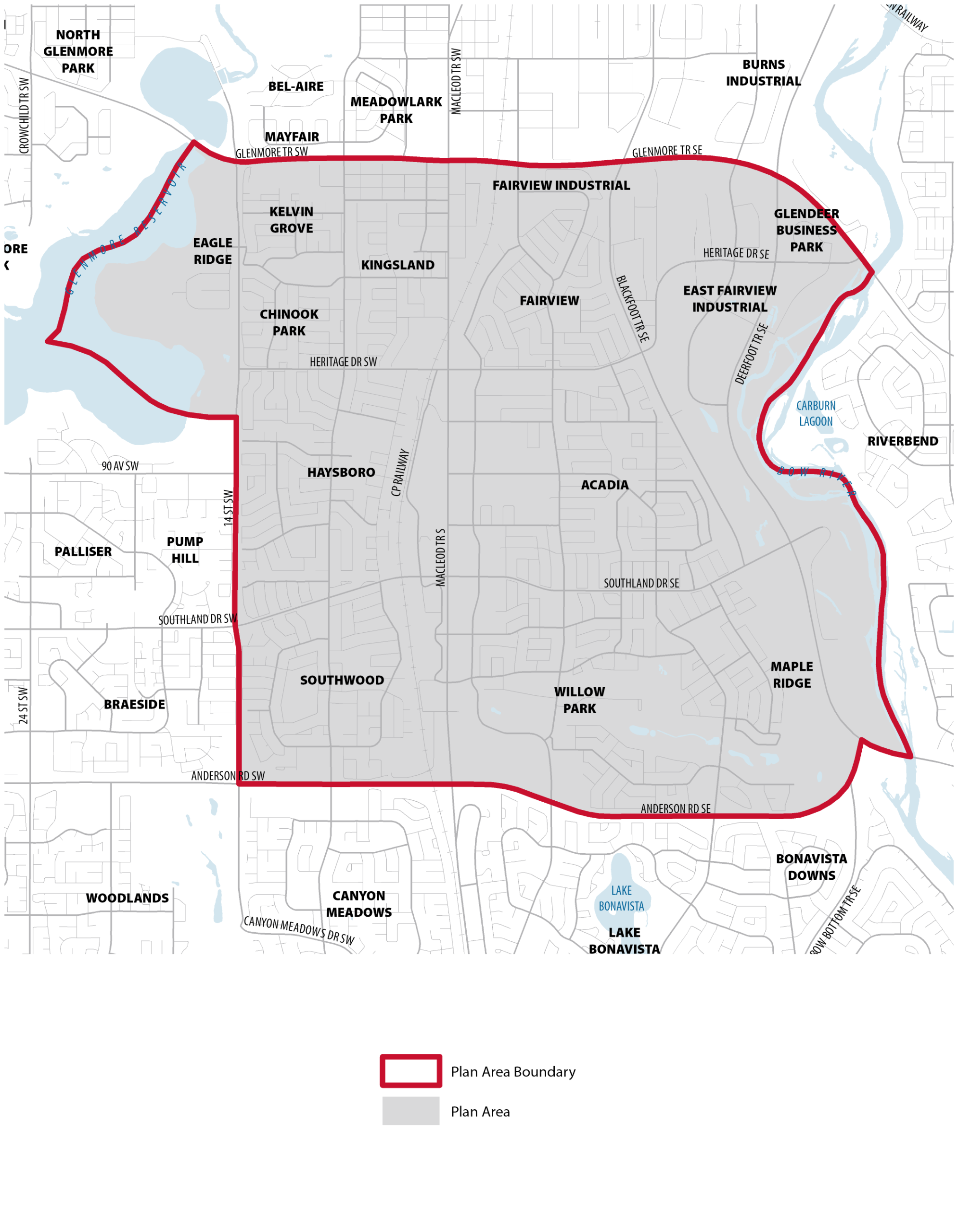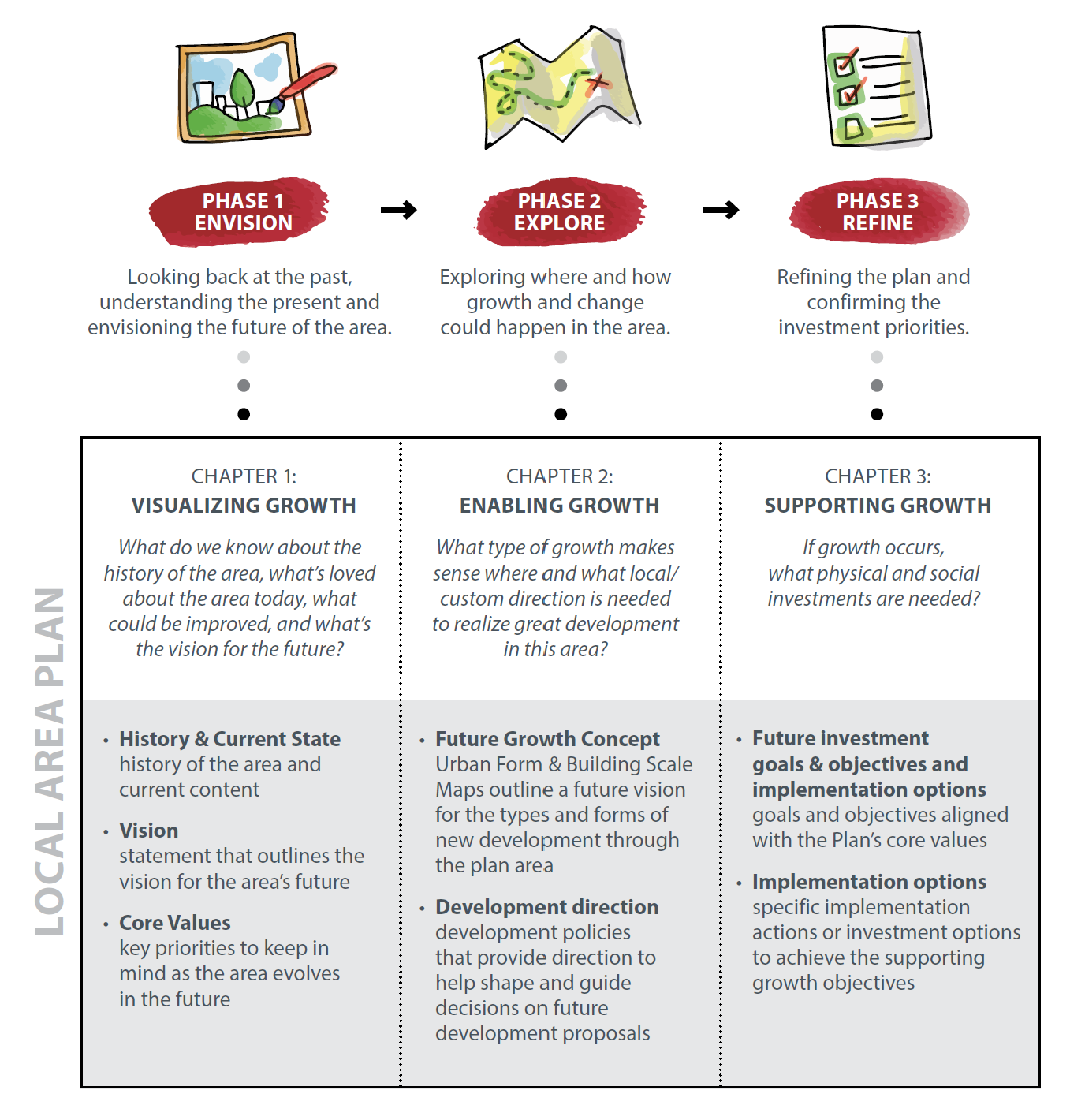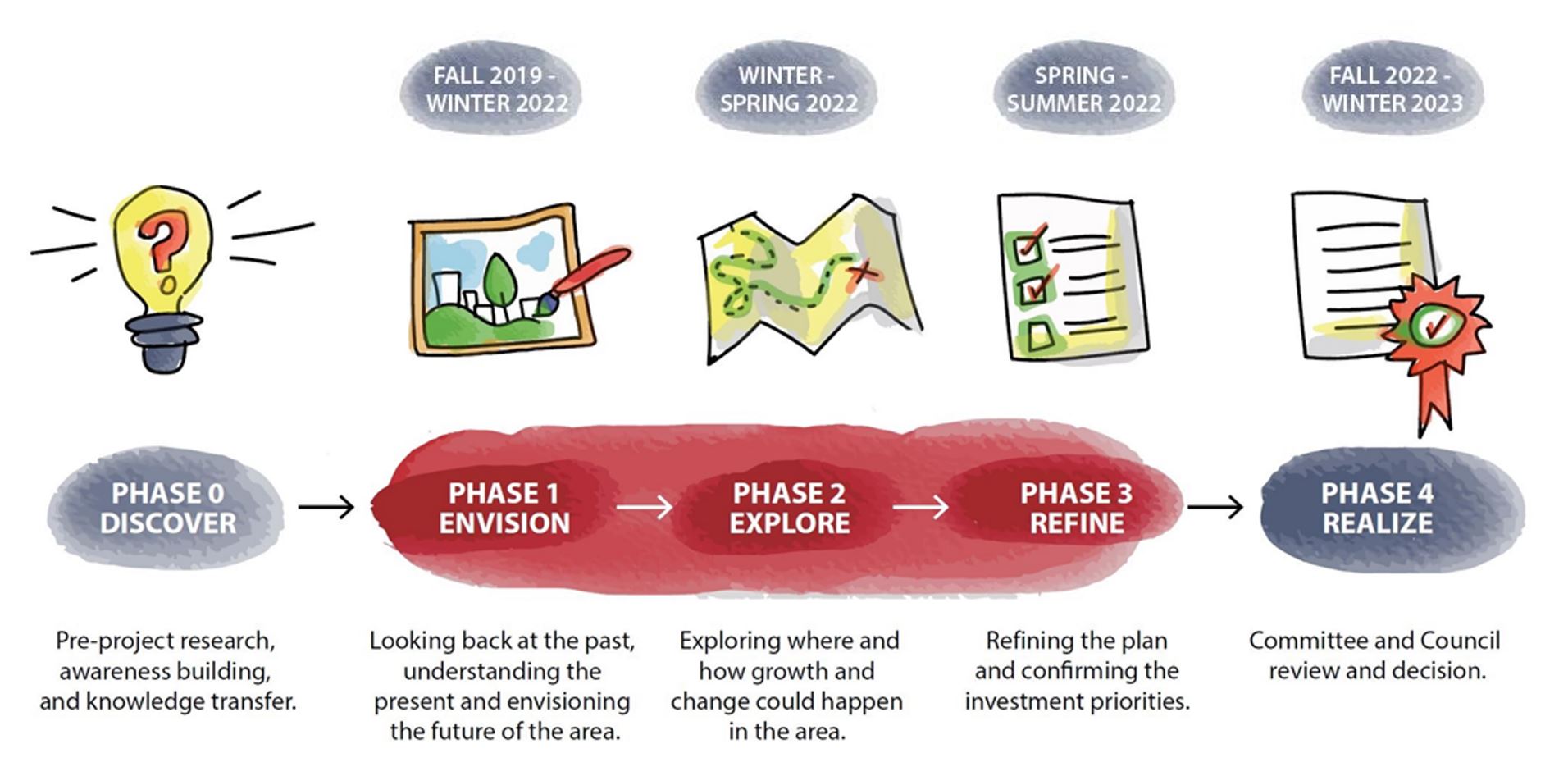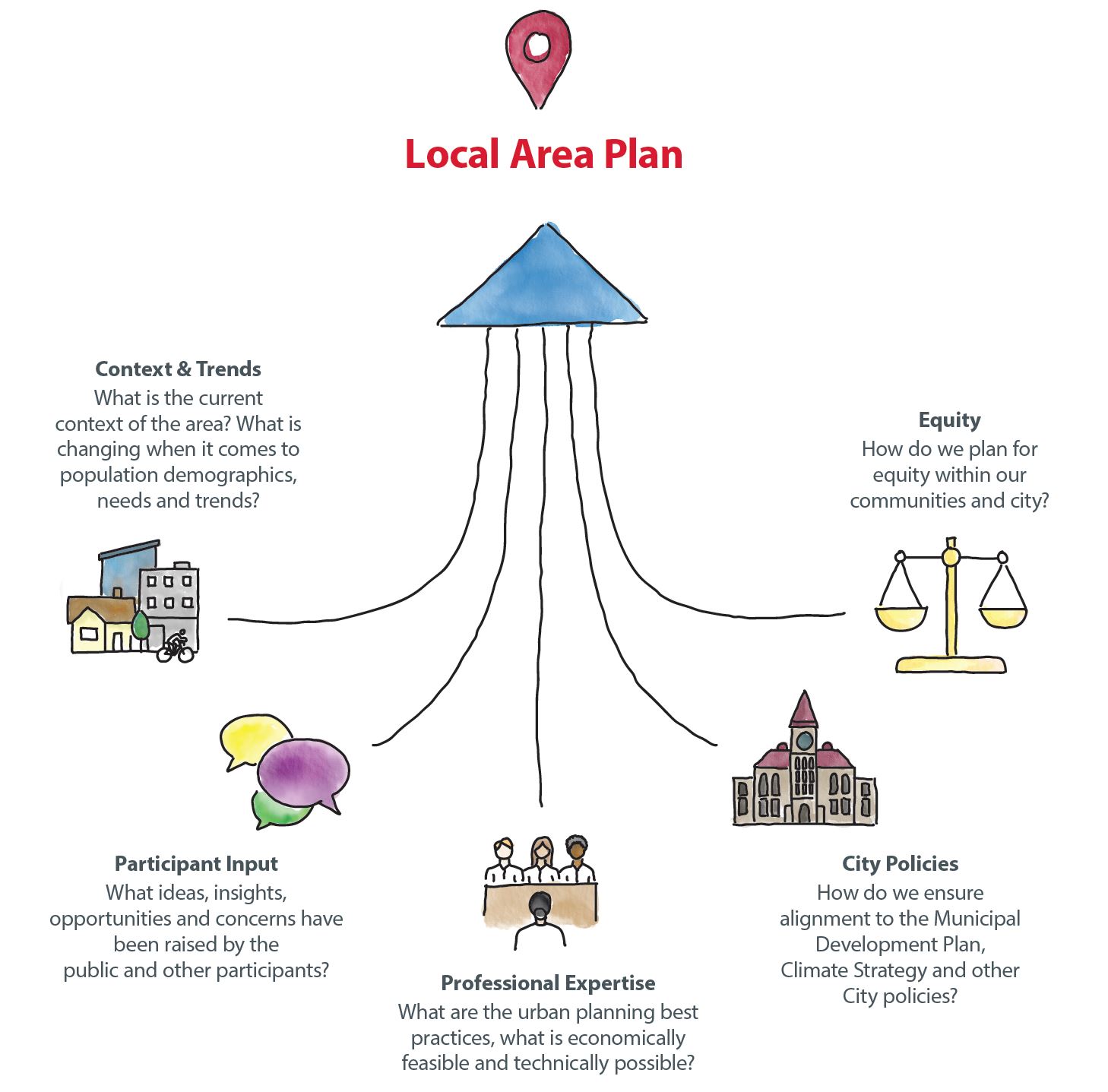Heritage Communities Local Area Plan
The Heritage Communities Local Area Plan has now concluded. For the most up-to-date information, please click the link below.
Heritage Communities Local Area Plan Approved by Council
On September 19, 2023, Council approved the Heritage Communities Local Area Plan with a 14-1 vote.
The Heritage Communities Local Area Plan (the Plan) is the result of over three years of engagement with participants including youth, seniors, residents, business owners, community association and development industry representatives, and a dedicated and diverse working group. Feedback provided by participants throughout the process helped shape and refine the Plan that was brought forward to Council.
The Heritage Communities Local Area Plan sets out the vision and policies to guide growth, change and investment over the next 30 years in the communities of Kelvin Grove, Eagle Ridge, Chinook Park, Kingsland, Haysboro, Southwood, Willow Park, Maple Ridge, Acadia, and Fairview; and, three Industrial Communities (Fairview Industrial, East Fairview Industrial, and Glendeer Business Park). In addition to policies directing how land can be used and redeveloped in the area, the Plan identifies community improvements and investments to support communities as they experience growth and change.
With the approval of the Heritage Communities Local Area Plan, there is now direction on future development, investment and community improvements that residents, landowners, builders/developers, City Planners and Councillors can commonly refer to when new development and investment ideas are proposed.
The Plan aims to support the area as it evolves by: better connecting the Heritage Communities; fostering vibrant Transit Station Areas; increasing housing choice; enhancing parks, open spaces and natural areas; and revitalizing the Macleod Trail South Area.
Thank you to everyone who dedicated their time and provided input throughout the creation of the Heritage Communities Local Area Plan!
What is this project about?
Communities change and evolve over time. Conversations about where, why and how revitalization and redevelopment should happen are essential to ensure our communities change in the right ways.
Through the local area planning process, we’ll work together to create a future vision for how land could be used and redeveloped in the area.
A local area plan outlines a future vision for the area, provides guidance on what growth and change makes sense where, and includes development direction that residents, landowners, builders and developers, city planners and Councillors can commonly refer to as new development ideas are proposed by property owners and landowners in the area.
Frequently Asked Questions
The Heritage Communities Local Area Planning project is one of the 42 multi-communities areas in the city. This project includes the the residential communities of Kelvin Grove, Eagle Ridge, Chinook Park, Kingsland, Haysboro, Southwood, Willow Park, Maple Ridge, Acadia, and Fairview; and, three Industrial Communities (Fairview Industrial, East Fairview Industrial, and Glendeer Business Park). These Industrial communities are considered different and independent communities, they are not part of the Fairview Communities or any other communities.
A new local area plan will fill gaps in communities/areas where no local plan currently exists and replace other plans that are largely outdated. In this project context, the local area plan will cover multiple communities and will be adopted by Council as an Area Redevelopment Plan.

A local area plan sets the vision for growth and change in a group of communities over the next 30+ years. A local area plan provides guidance and direction on development and investment that residents, landowners, builders/developers, City Planners and Councillors can commonly refer to when new ideas are proposed for the area.
All neighbourhoods change and evolve over time – buildings gain character, community demographics change, trees mature, local amenities and businesses change ownership and offerings.
Redevelopment is a natural part of a community’s life cycle, which often begins when communities reach a certain age and homes, buildings and amenities need to be revitalized or replaced. When communities reach this stage, a local area plan is a helpful tool to have in place to help guide decisions when new homes, developments and local investments are proposed and considered.
While Calgary’s population has been growing approximately 1.8 per cent every year since 1985, the peak population within 86 per cent of Calgary’s established communities has declined. In the Heritage Communities, for example, population has declined approximately 8% over the last 50 years.
Population stability within established communities is essential to support local schools, businesses, services and infrastructure. Greater housing choice and diversity supports increased population and stabilization within Calgary’s established communities.
Expanding the types of homes that can be built is a great way to improve housing choice in a community naturally over time – in turn supporting population stability, local schools, businesses, services and infrastructure.
No. The Local Area Plan itself does not rezone (redesignate) land. Property/landowners determine if and when to propose to rezone their land. If a land use rezoning were brought forward by a property/landowner, it would be reviewed for alignment with the Heritage Communities Local Area Plan if the Local Area Plan were approved by Council. The Local Area Plan provides direction that would inform and guide decisions about future development and zoning proposals in the area. If the Local Area Plan were not approved, applications to rezoning would be reviewed against the direction of broader Council-approved plans such as the Municipal Development Plan.
The City of Calgary may propose to redesignate (rezone) land and does so periodically in connection with initiatives such as the Main Streets program or the Land Use Bylaw; however, no rezoning is being proposed in connection with the Heritage Communities Local Area Plan. Any proposals to rezone or redesignate a parcel must always include opportunities for public involvement and notification.
The City must review all proposals for development and land use rezoning. New development ideas and land use proposals always go through a detailed review and approval process. Public input on development and land-use (zoning) applications is an essential part of this process.
If a proposed development does not align to the existing zoning a land use redesignation (rezoning) application is required.
If a proposed development aligns with the existing zoning (as outlined in the Land Use Bylaw), a development permit is required.
Proposal to redesignate or rezone land are reviewed against applicable Council-approved policies, such as a local area plan (if/where one exists) and the Municipal Development Plan (if more detailed local guidance is not in place).
You can learn more and provide your input on all development and land use proposals at calgary.ca/development.
Single-detached and semi-detached homes are supported on every residential lot as they have the same maximum lot coverage and height, resulting in very similar looking homes, but with two doors and homes instead of one. Expanding the option to build a semi-detached home or a single-detached home will help support population renewal and continued community vitality.
Single-detached homes and semi-detached homes supported on all residential lots.
Areas closer to local amenities are seen as key areas to accommodate additional homes, people and growth. These areas could accommodate new single-detached homes, semi-detached homes and homes that are three storeys or less but include three units of more (such as rowhouses or townhomes). Welcoming more homes and people around LRT stations, larger parks, and on corner lots means more people can get around more easily and have access to green spaces.
In addition to single-detached and semi-detached homes, homes that are three storeys or less with three units or more (such as rowhouses and townhomes) are supported on parcels with a lane that is also within transit station areas, adjacent to a larger parks or on corner lots.
Larger multi-residential homes are also supported in specific areas including along Macleod Trail S, near transit stations, and in key locations along community corridors such as Elbow Drive SW, Heritage Drive S, Fairmont Drive SE, Acadia Drive SE, and 90 Avenue SE.
There have been considerable changes to the make-up of households in Calgary, and specifically in the Heritage communities over the last 50 years. Due to several factors, the average number of people living in a home over this period has substantially decreased. In the Heritage communities there were 4.27 people living in a home in 1969, and in 2019, it was 2.3. A major reason for this is the number of children per household has significantly decreased. To maintain the same number of children in a community, or increase it, more housing needs to be created for more households.
We also know that all forms of housing attract households with children. When new housing is added, such as replacing a bungalow with two semi-detached dwellings, or several homes with an apartment, the number of children in the community increases.
Simply put, communities that remain predominantly single-detached areas have seen the number of children in their neighbourhoods decrease and communities that have allowed new semi-detached homes, rowhouses, townhouses and apartments have seen an increase in the number of children living in them. In the Heritage communities, over the last 20 years, the communities of Kingsland and Haysboro have added 249 and 83 children (0-19 years old) respectively, while the communities of Acadia, Fairview, Maple Ridge, Southwood and Willow Park have lost 287, 113, 166, 223 and 218 children respectively (most other communities have lost children as well). Overall, the Heritage Communities have 766 children less than they did 20 years ago. While children do live in single-detached homes, more children are moving out of single-detached areas than are moving in. Keeping schools open means allowing more types of housing.
During the Local Area Planning process, the project team corresponds with local school boards to understand local school conditions and any other issues the school boards may have. By working together with the school boards, the plan team can better understand any potential issues with school capacity, pedestrian safety and traffic concerns, or any other issues facing local schools.
As we refine the plan and finalize the urban form category and scale modifier maps, our colleagues model potential growth scenarios based on the plan to understand how the population of the area can change over time. This model is then used by our transportation and water resources departments to analyze infrastructure capacity and usage based on that expected population growth. This analysis will help identify potential upgrades that may be needed as growth occurs in the plan area. This information is also shared with other utility partners, such as Enmax, so they can similarly forecast growth and infrastructure capacity and plan for upgrades.
A key part of the Local Area Plan is recognizing that public infrastructure and amenities need to support growth. In fact, an entire Chapter of the Plan, Chapter 3- Supporting Growth is dedicated to it. That Chapter outlines the goals and policies that will guide supporting investment and implementation options in the plan area as growth and change occurs. Goals such as improving mobility and safety, improving park spaces and increasing affordable housing are included. We are looking for public feedback on these goals to ensure we are capturing all the ways we need to support growth and change in the community.
City Council makes the final decision on land use zoning applications. Administration must review all rezoning proposals and makes a recommendation to Council based on planning merits, supporting policy and comments received. Council refers to the Local Area Plan and other City policy and holds a public hearing prior to making a decision. Council can make a decision based on their own interpretation of policies, site characteristics and the merits of the application.
The Local Area Plan provides high-level policy guidance and a framework for how growth and change could be accommodated in the plan area. The Local Area Plan identifies the urban form categories and building scale modifiers to identify where the different scales of growth and change should occur.
The current Land Use Bylaw outlines the rules and regulations for development of land in Calgary for each district (zone). It also outlines the process for making decisions for development permit applications. The Land Use Districts provide specific rules and requirements such as parking, lot coverage, allowable uses, setbacks and landscaping.
Other policies, guidelines and implementation tools provide further guidance for growth and change in a community.
A variety of opportunities for involvement were available through the process that aimed to accommodate a range of participation interests and intensities, as well as to remove barriers to participation.
Engagement opportunities and methods included: Heritage Communities Working Group sessions, in-person and virtual engagement sessions (with the public, community associations & development industry representatives), pop-up engagement events, online engagement, mailed engagement packages, My Idea Stations, Conversation Starter Kits and community walk & talks (with community association representatives).
Through the project, over 2 million advertisements were displayed to help raise awareness of the project and opportunities to get involved. Methods used to raise awareness included: mailed information, community newsletter articles and ads, large format road signs, social media ads (Facebook, Twitter, Instagram, Nextdoor), digital ads (including video ads on YouTube and audio ads on Spotify), digital and print ads in local restaurants, Communications Toolkits for area Councillors and Community Association representatives to help spread the word.
Over 30 public engagement events, 20 community association sessions, 13 working group sessions, and 4 builder/development industry sessions were held. Online engagement was open for 145 days and over 69,000 engagement packages/booklets were mailed to residents and businesses. Overall, there were over 3,000 unique instances of direct engagement and over 5,000 comments were shared.
Input provided by citizens and other participants helped the project team understand perspectives, opinions and concerns throughout the all phases of the project. Input collected in each phase of the project helped influence and inform the concepts and policies that were created and refined throughout the process. Throughout the project, the project team shared what was heard, highlighted the key themes raised, and provided responses for how key themes were addressed and considered.
Although it would be a great outcome, the goal of public engagement is not to reach consensus or make everyone happy. Public engagement is about considering the input, ideas and perspectives of those who are interested in or impacted by decisions, before decisions are made. Participant input is an important part of local area planning, but is one of many areas of consideration. Other areas include: City policies, professional expertise, current context and trends, and equity which all factor into the ultimate decision-making process and concept development.
Public input provided in each phase of the engagement process was compiled, reviewed and considered as each chapter of the local area plan was created.

One of the benefits of housing diversity and choice in a community is that it supports lifelong living as people’s needs change through their lifetime. Housing diversity offers different forms of homes that support the different needs of different people at different stages of their life.
All types of homes are used by all types of households. Just as you can find households with children living in semi-detached, duplex, rowhouse, townhouse and apartment homes, you can also find singles and couples without children in single-detached homes. The average number of children living in a typical rowhouse or townhouse in the Heritage communities is 0.56, while it is only 0.48 in single-detached homes.
Three-storey homes are already allowed to be built in every community. As long as a home is within the height and lot coverage allowed, it can be approved by The City. Some communities are already seeing older bungalows being torn down and replaced with three-storey homes, and this is allowed throughout the city. Over 550 new single-detached homes have been built in the Heritage Communities in the last 20 years, often replacing smaller bungalows with larger new homes.
No. Neither the Land Use Bylaw nor the Local Area Plan regulate the materials or architectural design of homes. The Bylaw does regulate built form, which includes things such as lot coverage, building height and landscaping requirements, but the architectural style of a home is up to each individual homebuilder and owner.
No. Semi-detached homes and duplexes generally have similar height and lot coverage as single-detached homes. Allowing semi-detached homes and duplexes doesn’t increase the allowable size of new homes, but it does allow two homes (plus suites) in a single building instead of one home (plus suite).
Those details are not in the scope of the Local Area Plan; however, at the development permit stage details such as building design, site constraints, landscaping, parking, utilities and waste and recycling staging areas are discussed and carefully looked at. Privacy is also discussed as part of the design of the new development. For example, glass blocks or frosted glass can be placed when side windows are proposed. All development permits include the opportunity for the public to provide comments during the review of the proposal as well as to appeal the decision about a proposed discretionary development.
Currently, the Land Use Bylaw permits small-scale homes including single-detached homes to be built up to three storeys; however, specific design details are looked at during the development permit stage. The proposed development should align with the contextual rules set in the Land Use Bylaw. In addition, during the development permit application review, the file manager reviews comments from the public and discusses options with the applicant to better integrate the new proposed development into the existing context.
Yes, the survey responses were taken in and reviewed. We responded to the CKE Community Association in May to confirm that we received and reviewed the results and that the results would be considered along with all of the other input received.
The survey results helped us understand some of the key concerns in the community, such as school closures, density and loss of parks/natural spaces. We still want and need additional feedback to further understand concerns and to work to find solutions. We appreciate your dedication and passion for the future of the CKE communities and we really encourage any solutions-oriented feedback that can help find the right balance between key concerns identified, including those raised through the CKE survey, such as:
“Finding a balance between limiting crowded densification and drawing enough young families in to maintain schools…”
“The biggest concern among respondents is keeping community schools open and viable.”
“Densification and Chinook Park School are the most significant concerns in the community.”
We know that community redevelopment is complex, change is difficult, and these conversations are not ones that everyone wants to have, but growth and change will happen with or without a local area plan in place. We need you to provide input and direction on how that looks. We want to have these discussions with you. We need to work together.
We need to further discuss concerns, challenges and opportunities surrounding population decline and school closures. School closures are directly tied to population decline and enrollment. The population in CKE was at its peak in the early 1970s and has declined due to a reduction in the number of people per home. We want and need to talk to you about potential solutions to this problem.
We need to work together to find ways to welcome more people into CKE in order to maintain population levels needed to support schools and other community amenities. We need to try to work together to find solutions that balance the need for more people, with concerns that come along with welcoming more people and homes.
Development of parks and natural spaces was also raised as a key concern. We agree that parks and natural spaces are very important to retain and we are not looking to redevelop these spaces, but rather ways we can improve and enhance them. We are currently seeking input on priority projects, such as parks or other key areas for improvement, that could be implemented in the future.
Timeline

-
Timeline item 1 - complete
DISCOVER & GET INVOLVED
- Learn more about the project
- Apply to be a member of the working group
-
Timeline item 2 - complete
ENVISION
Phase 1 initial: Winter 2019 - Spring 2020
- Share what you love about the community and your vision for the future.
Phase 1 validate: Fall 2021
- Looking back at the past, understanding the present and envisioning the future of the area.
- Provide input on the first chapter of the local area plan including: the area’s rich history (PAST), the area as it exists today (PRESENT), the vision for the area and core values that support this vision (FUTURE).
-
Timeline item 3 - complete
EXPLORE
Phase 2: Winter 2022
- Exploring where and how growth and change could happen in the area.
- Key topics, priorities, options and alternatives are explored, discussed and refined.
-
Timeline item 4 - complete
REFINE
Phase 3: Spring - Summer 2022
In this phase we'll focus on refining the plan content and concepts, and confirming investment priorities.
-
Timeline item 5 - active
REALIZE
Phase 4: Winter 2023 - Fall 2023
- Sharing the proposed local area plan and bringing it forward to Committee and Council.
IMPLEMENT - Ongoing
- Landowners decide if and when they want to develop or redevelop their land.
- If a landowner decides they want to redevelop their land under a different land use district (zone), they must apply for a land use redesignation.
- In some cases, The City (rather than a specific landowner) will rezone land. The City is more likely to rezone land if it is aligned with the long-term vision for growth and redevelopment such as in the Municipal Development Plan or local area plan.
- City Council is the decision maker on all land use amendements.
UPDATE & AMEND - Ongoing
- Local area plans are meant to be ‘living documents’ that may be amended and updated over time as the community changes and evolves and as conditions and circumstances in the area change.
- City Council is the decision maker on all local area plan amendments.
Past Engagement & What We Heard
Past Engagement Pages
What We Heard / What We Did reports
Check out the What We Heard Reports to learn what we heard from the public and other stakeholders in each phase of the engagement.
Check out the What We Did Reports to see the key 'What We Heard' themes raised in each phase as well as a summary of 'What We Did' in response to each of the key themes that were raised.
Key Themes Summary
Phase 1: ENVISION
Phase 2: EXPLORE
PHASE 3: REFINE
The City defines engagement as:









